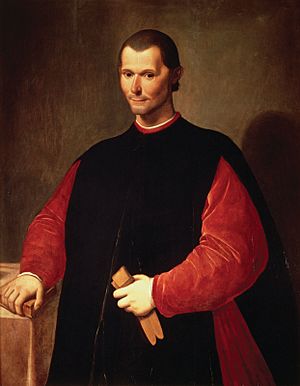Realism theory facts for kids
Realism theory is a way of thinking about how countries interact in the world. It focuses on being practical and seeing things as they really are. It's one of the main ideas in the study of international relations, which is about how different countries get along (or don't get along).
This theory helps explain Realpolitik, a style of statesmanship used in early modern Europe. Realpolitik means making decisions based on what's best for your country's power, not on ideals or morals. Realism suggests that countries are always trying to gain power, and this often leads to conflict. This idea is different from liberalism, which believes countries can cooperate and work together.
Realism has been around for a long time. Its ideas can be traced back to ancient thinkers like Thucydides.
What Realism Theory Is About
Jonathan Haslam describes realism as a range of ideas. These ideas usually follow four main rules:
- Countries are the most important players in global politics. Leaders or international groups like the United Nations are less important.
- There's no world government to make and enforce rules between countries. This means the international system is like a free-for-all, or "anarchic".
- Countries act in their own best interest. They make choices that help them survive and become stronger.
- Countries want power to keep themselves safe.
Realism is often linked to Realpolitik. Both are about getting and using power. However, Realpolitik is more about how leaders should act. Realism is a bigger idea that tries to explain and predict what happens between countries. It doesn't pick a side morally. It just tries to understand why countries behave the way they do. Some people describe realists as being like Niccolò Machiavelli, who believed leaders should do whatever it takes to make their nation powerful.
Different Kinds of Realism
Realists have different ideas about why countries fight for power. They can be divided into a few groups:
- Classical realists believe that conflict comes from human nature itself. They think people (and therefore countries) are naturally selfish and want power.
- Neorealists think conflict happens because there's no world government. Since no one is in charge, countries have to look out for themselves. This leads them to compete for power.
- Neoclassical realists combine both ideas. They believe conflict comes from human nature and the lack of a world government. They also think a country's own politics play a role.
Neorealists are also split into two groups:
- Defensive realists believe countries seek enough power to protect themselves, but not too much.
- Offensive realists believe countries should try to get as much power as possible to be truly safe.


